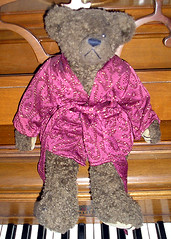I speak of Thomas Hampson, international opera star, featured soloist at the National Symphony Orchestra's "Music of Gustav Mahler" concert this past weekend at the John F. Kennedy Center for the Performing Arts.
 The evening opened with Hampson singing Kindertotenlieder, a poignant song cycle based on five poems by Friedrich Rüchert called "Songs on the Death of Children." This is not a flashy or dynamic work, but a quiet, introspective work, and a virtuosic opportunity for Hampson to display the sensitivity of his singing and the lyrical beauty of his vocal line. He did well, though he's finally "covering" a bit more than he used to when he's above his passagio, and I noticed he pushed into falsetto for one of the very high, soft phrases. One thing about Tommy, he's always the consummate artist.
The evening opened with Hampson singing Kindertotenlieder, a poignant song cycle based on five poems by Friedrich Rüchert called "Songs on the Death of Children." This is not a flashy or dynamic work, but a quiet, introspective work, and a virtuosic opportunity for Hampson to display the sensitivity of his singing and the lyrical beauty of his vocal line. He did well, though he's finally "covering" a bit more than he used to when he's above his passagio, and I noticed he pushed into falsetto for one of the very high, soft phrases. One thing about Tommy, he's always the consummate artist.After the intermission, supplemented by quite a number of players that had the orchestra completely filling the stage, the NSO played the lengthy Symphony No. 6 in A minor. Musicologists seem to think the 6th is Mahler's most important work, though I think probably only the 2nd ("Resurrection") is well known to those who frequent the concert hall, and the 6th, while interesting, has never been a great favorite of mine.
What I noticed most in watching this live performance of the 6th was the instrumentation. There were, for example, not one, but four harpists. There was an entire rack of cow bells of various sizes. And, most melodramatically, the score calls for the use of a "hammer." Well, hammer doesn't quite convey the right idea: think maul. The stage arrangement made the hammer's use unintentionally comical, too. A large, desk-looking box sat off to the far downstage left corner of the stage. When it was time for the hammer, a percussionist walked from the back row of the instruments where the drums and more conventional percussion instruments sat to the big box, and with all the dignity that only an orchestra percussionist in white tie and tails can muster, delicately picked up the maul, then with a big back swing, thunked that box like a carnival worker setting big top tent pegs.
Otherwise, the Mahler is a massive work, and one that keeps all sections of the orchestra unusually busy. He particularly makes extensive use of the low brass. The four harps were needed, indeed, since in some harp passages, the rest of the orchestra was playing fortissimo, and the quadruplication was needed so we could hear the harp.
Leonard Slatkin was back on the podium. Alas, he was back to his old ways, and not conducting with the magic he'd elicited in the fall. There were throughout the evening synchronization problems, particularly between the strings and the brass/woodwinds. I also noticed a rather disconcerting feel of the brass and winds sounding like someone had put the treble on the equalizer on maximum. The orchestra got somewhat better as the evening dragged on, but it was rather too little too late.
After the concert, Hampson was to be sitting out in the Grand Foyer outside the Concert Hall autographing his CDs. We slipped out a side door of the hall to leave and it completely slipped my mind to go out the back doors of the hall so we could slip by and say hello. Oh, well, it would have been awkward trying to talk with all the other fans bunching around.

No comments:
Post a Comment